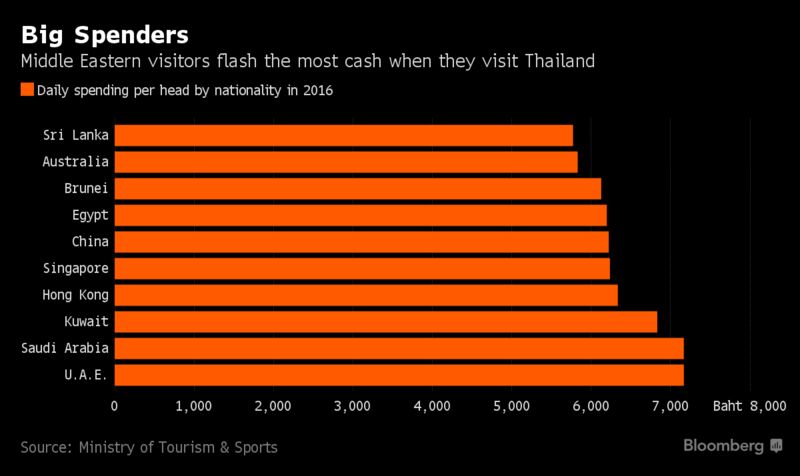Thailand Wants More Of Tourist Who Acts Like Australians
Thailand has become more famous for holidays that almost 35 million foreign tourists equivalent to half the country’s population are expected this year.
As the arrival of large numbers of people gets harder to manage, the government is shifting strategy. It’s now targeting a minimum increase in tourism revenue of about 5 percent annually instead of a particular number of visitors, Tourism Minister Kobkarn Wattanavrangkul said. That means encouraging longer stays and higher daily spending, a mix the typical Australian holidaymaker exemplifies, she said.“Maybe they’re the ones who are like: this is my time -- I eat, I shop, and I eat, and I shop," Kobkarn, 56, said in an interview.
Australian visitors were among the top 10 biggest spenders in terms of per capita daily expenditure last year, forking out 5,831 baht ($172), Tourism Ministry data shows. Their average length of stay of almost 14 days was the highest in that group. Some nationalities take even longer holidays but tend to be more parsimonious. British tourists, for instance, stayed for just over 18 days on average while spending 4,376 baht daily.
Tourism is a bright spot for Thailand’s economy, which faces challenges such as political uncertainty and sluggish consumer demand. The sector makes up about 18 percent of gross domestic product, Kobkarn said in the interview in Chiang Mai last month.
“We no longer have a target for number of tourists,” she said. “We
shouldn’t go beyond the limit that we can cope. But there’s no statistic
on that yet. When people say that Phuket may be too crowded, or Bangkok
is too crowded, we have to make sure that we are introducing new
destinations too.”
The arrivals from overseas more than doubled in the past decade, powered by a surge in Chinese holidaymakers who contributed 28 percent of 1.6 trillion baht in foreign tourism receipts in 2016.
Affordability is one reason why Thailand has usurped Malaysia as
Southeast Asia’s most popular destination, but Kobkarn said the nation
must focus on quality as well as cost to tackle emerging competitive
threats from the likes of Myanmar and Vietnam.
Quality doesn’t just mean targeting wealthy tourists as Thailand needs travelers on a variety of budgets, Kobkarn said. Instead, it refers to offering good value experiences that encourage return visits, increase the average length of stay and bolster daily spending per head, she said.
Thailand’s years-long tourism boom slowed somewhat in recent months. That’s because of terrorist bombings in resort towns in August last year and a clampdown by the military government on some operators of large Chinese tour groups, which were judged to generate insufficient local spending.
The Bank of Thailand forecasts 34.9 million tourist arrivals this year, a climb of about 7 percent from 2016, and 37.3 million in 2018. That’s projected to help Southeast Asia’s second-largest economy expand 3.5 percent in 2017 and 3.7 percent next year.
Thailand needs to be a quality tourism destination since a range of factors can prevent it being seen as the cheapest, such as rising wages or an appreciating exchange rate, Kobkarn said.
“We’re working very hard for people not to think only of the cost,” she said. “We’re not the best. We still have many negative things. But we’re very sincere in improving ourselves.”
Source
As the arrival of large numbers of people gets harder to manage, the government is shifting strategy. It’s now targeting a minimum increase in tourism revenue of about 5 percent annually instead of a particular number of visitors, Tourism Minister Kobkarn Wattanavrangkul said. That means encouraging longer stays and higher daily spending, a mix the typical Australian holidaymaker exemplifies, she said.“Maybe they’re the ones who are like: this is my time -- I eat, I shop, and I eat, and I shop," Kobkarn, 56, said in an interview.
Australian visitors were among the top 10 biggest spenders in terms of per capita daily expenditure last year, forking out 5,831 baht ($172), Tourism Ministry data shows. Their average length of stay of almost 14 days was the highest in that group. Some nationalities take even longer holidays but tend to be more parsimonious. British tourists, for instance, stayed for just over 18 days on average while spending 4,376 baht daily.
Tourism is a bright spot for Thailand’s economy, which faces challenges such as political uncertainty and sluggish consumer demand. The sector makes up about 18 percent of gross domestic product, Kobkarn said in the interview in Chiang Mai last month.
 | ||
| IMAGE CREDIT: Bloomberg |
The arrivals from overseas more than doubled in the past decade, powered by a surge in Chinese holidaymakers who contributed 28 percent of 1.6 trillion baht in foreign tourism receipts in 2016.
 |
| IMAGE CREDIT: Bloomberg |
Quality doesn’t just mean targeting wealthy tourists as Thailand needs travelers on a variety of budgets, Kobkarn said. Instead, it refers to offering good value experiences that encourage return visits, increase the average length of stay and bolster daily spending per head, she said.
Thailand’s years-long tourism boom slowed somewhat in recent months. That’s because of terrorist bombings in resort towns in August last year and a clampdown by the military government on some operators of large Chinese tour groups, which were judged to generate insufficient local spending.
The Bank of Thailand forecasts 34.9 million tourist arrivals this year, a climb of about 7 percent from 2016, and 37.3 million in 2018. That’s projected to help Southeast Asia’s second-largest economy expand 3.5 percent in 2017 and 3.7 percent next year.
Thailand needs to be a quality tourism destination since a range of factors can prevent it being seen as the cheapest, such as rising wages or an appreciating exchange rate, Kobkarn said.
“We’re working very hard for people not to think only of the cost,” she said. “We’re not the best. We still have many negative things. But we’re very sincere in improving ourselves.”
Source

Comments
Post a Comment